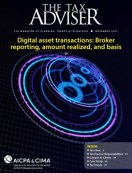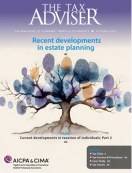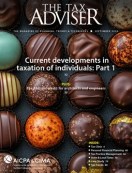- newsletter
- TAX INSIDER

Maximizing deductions on like-kind exchanges using cost segregation
Tax advisers should consider tax basis calculation options on the exchanged properties before recommending a cost segregation study.
Please note: This item is from our archives and was published in 2020. It is provided for historical reference. The content may be out of date and links may no longer function.
Related
Navigating tax changes with statistical sampling
Timing of revenue: Prop. regs. issued under Sec. 451(b)
Advance payments for goods and services
When a property is acquired in a Sec. 1031 like-kind exchange, tax preparers should consider several facts before deciding how to best depreciate the carryover basis from a relinquished property. When a cost segregation study is also considered on the newly acquired property, additional analysis is recommended before finalizing the Sec. 1031 tax basis calculations. Making matters more complicated, these Sec. 1031 tax basis calculations are needed before a cost segregation study can be recommended. This article will help practitioners understand how to maximize accelerated deductions by examining a number of Sec. 1031 exchange rules and how they are affected by cost segregation studies.
Cost segregation and tax basis
A cost segregation study dissects the purchase price or “tax basis” of a building property that would normally be depreciated over 27.5 years for residential property or 39 years for commercial property. The primary goal of cost segregation is to identify components that are not real property and therefore can be depreciated faster (typically over five, seven, and 15 years). When a property is purchased in a Sec. 1031 exchange, the tax basis calculations can vary significantly depending on the circumstances. More information on this below.
Bonus depreciation
Current tax law allows for 100% bonus depreciation on certain property, new or used, purchased after Sept. 27, 2017. Bonus depreciation applies to property with a tax life of 20 years or less (i.e., it doesn’t apply to real property). As a result, a cost segregation study will identify tangible personal property that qualifies for bonus depreciation, thereby saving a significant amount on taxes. Furthermore, only the “excess basis” of property acquired after Sept. 27, 2017, through a Sec. 1031 exchange qualifies for bonus depreciation. Therefore, a property with large excess basis benefits significantly more from cost segregation because of bonus depreciation.
Example: A property was sold in a Sec. 1031 exchange for $1 million. There was $700,000 of depreciation leftover at the time of the exchange (aka “carryover basis”). The new property that is received in the Sec. 1031 exchange is purchased for $1,500,000. Only the excess basis of $500,000 ($1,500,000 – $1,000,000) is eligible for bonus depreciation.
Like-kind exchange depreciation options
Option 1: Generally, taxpayers must depreciate the carryover basis of property acquired in a like-kind exchange during the current tax year over the remaining recovery period of the property exchanged. They must use the same depreciation method and convention that was used for the relinquished property. Any excess basis is treated as newly placed in service property. Depreciation must be calculated separately for the carryover basis and the excess basis. This option is typically better when the relinquished property is closer to the end of its tax life.
Note: If this option is chosen, tax rules only allow a cost segregation study (for the new property) to apply to the excess basis, not to the carryover basis. Using the example above, a cost segregation study can only apply to $500,000.
Option 2 (simplified method): Taxpayers can elect to treat the adjusted basis of the exchanged property as if it was disposed of at the time of the exchange. Under this election a taxpayer treats the carryover basis and excess basis for the acquired property as if placed in service on the date acquired. The depreciable basis of the new property is the adjusted basis of the exchanged property plus any additional amount paid for it (or “net tax basis”). By making this election, the taxpayer may be able to use a more favorable method of depreciation and simplify recordkeeping.
Note: Under this option, tax rules allow a cost segregation study to apply to the combined carryover basis and excess basis. Using the example above, the cost segregation allocations apply to “net tax basis” of $1,200,000 ($700,000 carryover + $500,000 excess basis). In this case, the benefits of cost segregation can be significantly higher than under Option 1. Please note that bonus depreciation is only applied to the excess basis, regardless of which option is chosen.
Using the simplified method does not affect the application of like-kind exchange rules, or depreciation recapture rules, to the relinquished property. The election is made by attaching a statement to the income tax return indicating “Election made under Regs. Sec. 1.168(i)-6(i),” and describing the property.
When to recommend cost segregation studies
When a property is acquired using a Sec. 1031 exchange and cost segregation is also considered, tax preparers should contemplate maximizing the basis to which the cost segregation study can be applied. In addition, Sec. 1031 exchange basis calculations should be reviewed before recommending cost segregation studies to clients. Without this understanding, a cost segregation proposal may grossly overstate (or understate) potential tax savings. As such, planning ahead and working with a cost segregation firm that is highly experienced with 1031 exchanges is key.
— Gian P. Pazzia, CCSP, a principal in KBKG‘s national Cost Segregation group, is a recognized leader in his field. Among his many accomplishments, he has provided expert witness testimony before the IRS. To comment on this article or suggest an idea for another article, contact Sally Schreiber, a Tax Adviser senior editor, at Sally.Schreiber@aicpa-cima.com.














